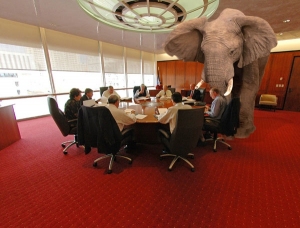April 25, 2012
 Elephant in the Room
Elephant in the Room
We have all heard the expression “Elephant in the room” as it describes the big issue (“elephant in the room”) that everyone obviously knows about but doesn’t want to talk about or deal with. It’s an expression used when an issue is so big it can’t be ignored.
It may be a challenge that crops up in an organization, but due to its complex, controversial or sensitive nature, no one wants to deal with it. Yet, without dealing with it adequately, stress and discomfort continues to build around the elephant in the room, as long as the issue has been unresolved.
So how do we rid of the elephant in the room? You may think it’s a simple task. To deal with it adequately and effectively, you as a business leader and your staff or stakeholders need to recognize it, expose it, and focus in on it. Bring it out in an open and transparent environment, sooner rather than later. The longer you as a leader leave deep rooted issues unresolved, the more attention this elephant gets. Staff anxiety and anger levels around the issue increase and it will deflect attention away from your productive work environment.
 Leadership to Tackle Elephant in the Room
Leadership to Tackle Elephant in the Room
As an entrepreneur, you need strong leadership skills in identifying challenges in your organization and to adequately find resolution. You need to have a few strategies in your back pocket to handle challenging circumstances.
Involving, empowering and encouraging staff and stakeholders to assist in problem solving will be a part of the overall resolution.
Identify the Elephant in the Room
In meetings, take on a new format of raising honest, deep-rooted problems in the organization. Encourage team members to speak freely about anything without any repercussions or reprimands. Time to get everything out in the open, and this is Step 1 … essentially issue identification.
Ask for Feedback and Recommended Solutions
With the elephant now exposed, time to wrap a harness around that elephant and give it some attention, meaning give the identified issue some attention. How do we walk that elephant right out of the room? Ask your valued team, stakeholders and customers for feedback and proposed solutions. And not engaging with those parties for resolution could have been the issue.
Take it step by step to issue resolution. Chances are that this issue is a complex one, and something that cannot be solved overnight. Take steps and demonstrate partial resolution. Now with interim milestones achieved, morale of all staff will have improved and the team will have some successes achieved.
Show Strong Leadership
With recommendations in hand from valued staff and stakeholders, show strong leadership by implementing solutions to those sensitive or complex challenges. Through your actions the elephant in the room will be eliminated for a stronger, more productive environment.
Business Planning to Resolve Elephant in the Room Syndrome
To be pro-active, ensure that in your business planning you should identify the serious, complex issues that you and your team will encounter. Your plan will set up resolution mechanisms and contingencies to handle the most challenging circumstances. You must be prepared to handle the difficult stuff that comes your way in your business.
Business information, resources and tips for the entrepreneur
© 2012 Strategy Plan One

